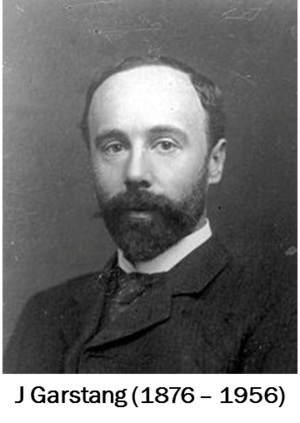John Garstang
Contents
Notes
Office Notes
House Notes
Proposed by J.L. Myres; seconded by A.C. Haddon and Henry Balfour 1902.10.28
Hon. Sec. Institute of Archaeology [1906]
Notes From Elsewhere
John Garstang (5 May 1876 – 12 September 1956) was a British archaeologist of the ancient Near East, especially Anatolia and the southern Levant. He was the younger brother of Professor Walter Garstang, FRS, a marine biologist and zoologist. Garstang is considered a pioneer in the development of scientific practices in archaeology as he kept detailed records of his excavations with extensive photographic records, which was a comparatively rare practice in early 20th century archaeology[1]
John Garstang was born in Blackburn on 5 May 1876, the sixth child of Walter and Matilda Garstang.[2] He was educated at Blackburn Grammar School and in 1895 he obtained a scholarship for Jesus College, Oxford to study mathematics.[2] While at Oxford, Garstang became interested in archaeology and conducted excavations at Ribchester.[2] Encouraged to take up archaeology, Garstang excavated other Romano-British sites during his vacations from Oxford.[2]
After gaining a 3rd from Oxford in 1899, Garstang joined the team of Flinders Petrie at Abydos. He excavated various sites in the vicinity, including the discovery of the great tombs at Beit Khallaf in 1901. In 1902 he carried out his first independent excavation in Egypt at Reqaqnah. The excavation was funded by an excavation committee, a group of wealthy donors who in would receive a selection of object from Garstang's excavations in exchange for their patronage.[1] Like Petrie before him, Garstang would continue to use Excavation Committees to fund his excavations for most of his career.
In 1902, Garstang was also appointed the honorary reader in Egyptian archaeology at the University of Liverpool.[2] In 1904, Garstang founded the Institute of Archaeology, which was affiliated with the University.[3] From 1907-1941, Garstang was the first professorship in the methods and practice of archaeology at the University. On behalf of the Institute, Garstang excavated sites in Egypt, Sudan and the Near East up to the out break of World War I.
He served as the Director of the Department of Antiquities in the British Mandate of Palestine between 1920-1926, and excavated at Ashkelon, 1920-1921. He was also the Head of the British School of Archaeology in Jerusalem, 1919-1926. He also carried out a major excavation of Jericho from 1930-1936, funded by Sir Charles Marston.[4]
He taught at the Egyptology section of the Faculty of Arts when this was established in the 1920s. One of his students was Pahor Labib, late Director of the Coptic Museum, Cairo.[5]
From 1936 to the outbreak of World War II, Garstang excavated Yümük Tepe near Mersin.[2] Garstang returned to Turkey after the War, and finished the excavation in 1948.[2] In 1948, Garstang founded the British Institute of Archaeology at Ankara, acting as its first director (he was succeeded by Seton Lloyd).
Publications
External Publications
The burial customs of ancient Egypt, 1907; The heritage of Solomon, [1934]; The land of the Hittites, 1910; Prehistoric Mersin, 1953
Garstang, John (1897). A History of Blackburn Grammar School. North-East Lancashire Press Co.
——— (1901). El Arábah: a cemetery of the Middle Kingdom: survey of the Old Kingdom temenos: graffiti from the temple of Sety. Egyptian Research Account. 6. London: Bernard Quaritich. OCLC 3904458. Retrieved 2016-05-23.
——— (1903). Maḥâsna and Bêt Khallâf. Egyptian Research Account. 7. London: Bernard Quaritich. OCLC 3578216. Retrieved 2016-05-22.
——— (1904). Tombs of the third Egyptian dynasty at Reqâqnah and Bêt Khallâf. Westminster: Archibald Constable & Co. OCLC 4912003. Retrieved 2016-05-22. ———; Newberry, Percy E. (1907). A Short History of Ancient Egypt. London: Archibald Constable & Co. OCLC 776949763.
——— (1907). The Burial Customs of Ancient Egypt as illustrated by tombs of the Middle Kingdom, being a report of excavations made in the necropolis of Beni Hassan during 1902-3-4. London: John Constable. OCLC 1862428.
——— (1910). The Land of the Hittites: an account of recent explorations and discoveries in Asia Minor, with descriptions of the Hittite monuments. London: Constable and Company, Ltd. OCLC 1932675.
——— (1911). Meroë, the city of the Ethiopians: being an account of a first season's excavations on the site, 1909-1910. Oxford: Clarendon Press. OCLC 4911995.
——— (1924). The excavations at Askalon. Annual report (Smithsonian Institution), 1922. Washington: G.P.O. OCLC 24016431.
——— (1929). The Hittite Empire: being a survey of the history, geography and monuments of Hittite Asia Minor and Syria. London: Constable and Company, Ltd. OCLC 16747179.
——— (1931). The Foundations of Bible History: Joshua, Judges. Foundations of Bible History. London: Constable & Co. OCLC 937776.
———; Spencer, Herbert (1934). The Heritage of Solomon: an historical introduction to the sociology of ancient Palestine. London: Williams and Nortgate. OCLC 3191377. ——— (September 20, 1936). "Reprint from "Palestine in Peril". The Observer.
———; Garstang, John B. E. (1940). The Story of Jericho. London: Hodder & Stoughton. OCLC 314782750.
———; Garstang, Hetty (Oct 1947). "A Conspectus of Early Cilician Pottery". American Journal of Archaeology. LI (4): 370–388.
——— (1950). "Traveller's Quest". In Michael, M. A. Original Contributions towards a Philosophy of Travel. William Hodge and Co. Ltd.
——— (1953). Prehistoric Mersin, Yümük Tepe in Southern Turkey: the Neilson Expedition in Cilicia. London: Oxford at the Clarendon Press. OCLC 1721677.
———; Gurney, O. R. (1959). "The Geography of the Hittite Empire". Occasional publications of the British Institute of Archaeology at Ankara. 5. London: British Institute of Archaeology at Ankara. OCLC 404320
